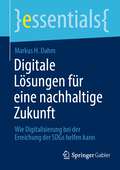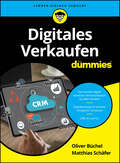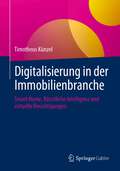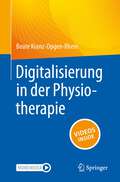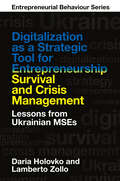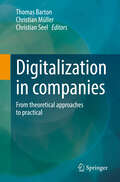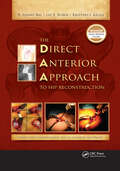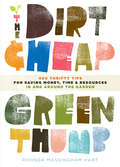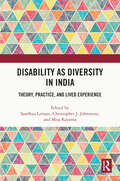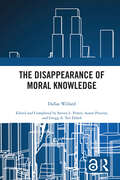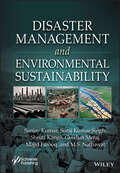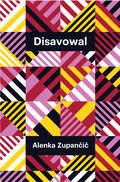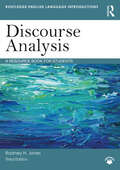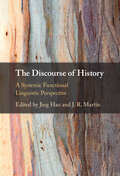- Table View
- List View
Digitale Lösungen für eine nachhaltige Zukunft: Wie Digitalisierung bei der Erreichung der SDGs helfen kann (essentials)
by Markus H. DahmDieses Buch wirft einen Blick auf die Verbindung zwischen Digitalisierung und den 17 Zielen für nachhaltige Entwicklung der Vereinten Nationen. Es erkundet die vielfältigen Wege, auf denen digitale Technologien dazu beitragen können, die UN-Ziele zu erreichen – von der Bekämpfung von Armut und Hunger bis hin zur Förderung von Geschlechtergleichstellung und nachhaltigen Städten. Inspirierende Fallstudien zeigen, wie Unternehmen weltweit bereits erfolgreich Technologien für das Gemeinwohl einsetzen, konkrete Beispiele veranschaulichen die Inhalte. Kritische Fragen regen eine ausgewogene Diskussion über die Herausforderungen und ethischen Aspekte der Technologienutzung für nachhaltige Entwicklung an. Wie können wir sicherstellen, dass technologische Fortschritte inklusiv und für alle zugänglich sind? Welche Risiken birgt die Digitalisierung für Umwelt und Gesellschaft?
Digitale Schriftlichkeit: Programmieren, Prozessieren und Codieren von Schrift (Literatur in der digitalen Gesellschaft #8)
by Martin Bartelmus Alexander NebrigDigitale Schriftlichkeit verändert und durchdringt unseren Alltag: Jedem normalsprachlichen Text auf Bildschirmen unterliegt ein schreib- wie lesbarer Code. Die Fragen »Wer schreibt?« und »Wer liest?« wandeln sich in diesem Kontext zu »Wer programmiert?« und »Wer prozessiert?«. Die Beiträger*innen widmen sich diesem Phänomen und verstehen das Codieren als Praxis der Schriftlichkeit. Es zeigt sich: Die Digitalisierung formt Schreiben und Schrift in einer Art und Weise um, die weit über die unterschiedlichen semiotischen und symbolischen Ebenen von Code und Schrift hinausgeht.
Digitale Technik für ambulante Pflege und Therapie III: Nutzung, Akzeptanz, Wirkung und Lebensqualität (Regensburger Beiträge zur Digitalisierung des Gesundheitswesens #4)
by Sonja Haug Karsten Weber Norina Lauer Christa Mohr Andrea Pfingsten Georgios Raptis Gudrun BahrWie können Roboter bei ambulanten Pflege- und Therapiemaßnahmen nach einem Schlaganfall helfen? Die Beiträger*innen fassen die Ergebnisse des Forschungsprojekts »DeinHaus 4.0 Oberpfalz« zusammen, bei dem interdisziplinäre Forscher*innen im Rahmen einer Längsschnittstudie den Einsatz von Telepräsenzrobotern empirisch untersuchen. Die unterschiedlichen Perspektiven der angewandten Ethik, E-Health, Logopädie, Physiotherapie, Pflegewissenschaft, Soziologie und Technikfolgenabschätzung legen nahe: Die Digitalisierung lässt sich gewinnbringend zur Unterstützung der Gesundheitsversorgung einsetzen.
Digitales Verkaufen für Dummies: Virtuelle Kommunikation im Vertrieb (Für Dummies)
by Matthias Schäfer Oliver BüchelDigitalisierung für Vertriebserfolge optimal einsetzen Digitales Verkaufen bietet Ihnen jede Menge neuer Chancen. Entwickeln Sie ein neues Mindset und eine erfolgreiche Vertriebsstrategie. Nutzen Sie zusätzliche Vertriebskanäle sowie neue Formen der Kommunikation mit Ihren Kunden. Wie Sie die digitale Klaviatur sicher spielen, Ihre Kunden auf virtuellem Weg ansprechen und digitale Verkaufsabschlüsse erreichen, verraten Ihnen die beiden Verkaufsexperten Oliver Büchel und Matthias Schäfer in ihrem Buch. Sie werden Ihre Kunden digital in den Mittelpunkt rücken und Ihre Produkte oder Dienstleistungen bei Ihrer Zielgruppe noch besser platzieren können. Sie erfahren Wie Sie eine digitale Vertriebsstrategie entwickelnWie CRM, Social Selling, KI, Virtual und Augmented Reality Sie beim Verkaufen unterstützen könnenWie virtuelle Kundenbeziehungen funktionierenWie Sie die neuen Kommunikationsformen richtig einsetzen
Digitalisierung in der Immobilienbranche: Smart Home, Künstliche Intelligenz und virtuelle Besichtigungen
by Timotheus KünzelDieses Buch vermittelt Fach- und Führungskräften aus der Immobilienbranche praxisnah die Potenziale moderner digitaler Tools und Applikationen für ihr tägliches Geschäft. Dazu beschreibt der Autor zunächst kurz die letzten Jahre des digitalen Wandels. Gleichzeitig präsentiert er bereits einige konkrete Beispiele (zu Verhaltensweisen, Kundenbedürfnissen und Marktverhältnissen), die den Wandel im Laufe der letzten Jahre verdeutlichen. Anschließend erklärt Timotheus Künzel zunächst die verschiedenen Funktionalitäten von Immobilien (selbstgenutzte Immobilie, Immobilie als Kapitalanlage) sowie die Geschäftspraktiken mit Immobilien (Immobilienmakler, Projektentwickler, Fix & Flip, Buy & Hold), bevor er sich dann eingehend dem Thema Digitalisierung in der Immobilienbranche widmet. Kenntnisreich und mit vielen Veranschaulichungen macht er deutlich, welche Technologien in welchen Stufen des Geschäfts vielsprechend sind (Blockchain, KI, Tokenisierung etc.). Auf diese Weise lernt der Leser die Digitalisierung Schritt für Schritt zu verstehen und zu nutzen.
Digitalisierung in der Physiotherapie
by Beate Kranz-Opgen-RheinIn diesem Praxisbuch finden Sie die notwendigen Informationen rund um das Thema Digitalisierung in der Physiotherapie. Wie kann die ePA meinen Praxisalltag erleichtern? Welche Datenschutzrichtlinien muss ich bei der Videotherapie beachten? Wer übernimmt die Kosten für die Online-Beratung ohne Rezept? Die Experten liefern Ihnen die Antworten!Aus dem Inhalt:Chancen, Grenzen und Gefahren der Digitalisierung in der PhysiotherapieDigitale PraxisorganisationDigitale Therapieangebote wie z. B. Physiocoaching und VideotherapieRechtliche Rahmenbedingungen, Datenschutz und MarketingPlus: Videos via MoreMedia-App veranschaulichen die Umsetzung in die Praxis optimal!Erweitern Sie Ihre Praxis um zeitgemäße Therapieangebote und profitieren Sie von den Vorteilen der Digitalisierung!
Digitalization as a Strategic Tool for Entrepreneurship Survival and Crisis Management: Lessons from Ukrainian MSEs (Entrepreneurial Behaviour)
by Lamberto Zollo Daria HolovkoDigitalization has recently emerged as a critical strategy for businesses to survive during disruptive times and crises. By utilizing digital tools, enterprises can enhance their communication capabilities, achieve cost savings, access new markets, implement data-driven and efficient decision-making processes, and maintain contact and alignment with key stakeholders regardless of market conditions. However, scant attention has been paid to how micro and small enterprises (MSEs) exploit digitalization to cope with recent crises. Digitalization as a Strategic Tool for Entrepreneurship Survival and Crisis Management: Lessons from Ukrainian MSEs investigates the impact of digital transformation on the survival of MSEs during times of crisis, guided by Ukraine as an emblematic empirical case study. The choice of Ukrainian MSEs as the research context is based on the prospect of obtaining valuable insights by examining micropreneurs during an ongoing crisis stemming from the 2022 military invasion by Russia and the residual effects of the pandemic. The ongoing socio-economic situation in Ukraine is being scrutinized in real-time, providing a distinctive opportunity to analyze its impact on entrepreneurs’ behavior during their efforts to stabilize businesses and the predominant challenges that most MSEs confront. The book offers significant insights into the potential benefits of digitalizing business models, management capabilities of micropreneurs, and employing multi-stakeholder and omnichannel communication strategies, which micropreneurs can utilize. The Entrepreneurial Behaviour series is focused on expanding the scope of Entrepreneurial Behaviour theory and analysis and enriching practice by encouraging multi-cultural and multi-disciplinary approaches.
Digitalization as a Strategic Tool for Entrepreneurship Survival and Crisis Management: Lessons from Ukrainian MSEs (Entrepreneurial Behaviour)
by Lamberto Zollo Daria HolovkoDigitalization has recently emerged as a critical strategy for businesses to survive during disruptive times and crises. By utilizing digital tools, enterprises can enhance their communication capabilities, achieve cost savings, access new markets, implement data-driven and efficient decision-making processes, and maintain contact and alignment with key stakeholders regardless of market conditions. However, scant attention has been paid to how micro and small enterprises (MSEs) exploit digitalization to cope with recent crises. Digitalization as a Strategic Tool for Entrepreneurship Survival and Crisis Management: Lessons from Ukrainian MSEs investigates the impact of digital transformation on the survival of MSEs during times of crisis, guided by Ukraine as an emblematic empirical case study. The choice of Ukrainian MSEs as the research context is based on the prospect of obtaining valuable insights by examining micropreneurs during an ongoing crisis stemming from the 2022 military invasion by Russia and the residual effects of the pandemic. The ongoing socio-economic situation in Ukraine is being scrutinized in real-time, providing a distinctive opportunity to analyze its impact on entrepreneurs’ behavior during their efforts to stabilize businesses and the predominant challenges that most MSEs confront. The book offers significant insights into the potential benefits of digitalizing business models, management capabilities of micropreneurs, and employing multi-stakeholder and omnichannel communication strategies, which micropreneurs can utilize. The Entrepreneurial Behaviour series is focused on expanding the scope of Entrepreneurial Behaviour theory and analysis and enriching practice by encouraging multi-cultural and multi-disciplinary approaches.
Digitalization in companies: From theoretical approaches to practical
by Thomas Barton Christian Müller Christian SeelThe book conveys current approaches to digitization in companies and shows how digitization projects can be successfully and safely implemented in practice. Based on the description of a changing value creation and working world, the changes associated with digitization are explained using application scenarios: New business models and business processes are being established, the development of products is changing as is the interaction with customers, new opportunities but also new risks are emerging. The authors of the article present the basics as well as concepts for the concrete planning and implementation of the digitization of processes and applications. Aspects of IT security are not neglected either. The editors' work is based on questions from entrepreneurial practice and is also suitable for students and teachers.
The Direct Anterior Approach to Hip Reconstruction
by B. Bal Lee Rubin Kristaps KeggiTotal hip arthroplasty has steadily evolved to improve patient outcomes and safety. One innovation has been to incorporate less invasive surgical methods, such as the direct anterior surgical approach. The Direct Anterior Approach to Hip Reconstruction is a comprehensive reference text that addresses contemporary surgeon interest in innovation and less invasive surgery. This resource will help with introductory learning, intermediate technical development, and advanced revision total hip skills using the direct anterior technique. Accordingly, the text is structured into three sections as follows: Basic concepts: Surgical hip anatomy, patient selection, and placement of single, multiple, and extensile incisions for primary total hip arthroplasty Intermediate concepts: Adoption of imaging and navigation technologies, use of traction tables to enhance positioning, and presentation of unique instruments and custom devices that have evolved specifically for the direct anterior approach Advanced concepts: Using the direct anterior approach for bearing and liner exchanges, acetabular revisions, femoral component revisions, and both component revisions. Drs. B. Sonny Bal, Lee E. Rubin, and Kristaps J. Keggi have combined their unique perspectives, along with those of a renowned group of North American and European experts in the anterior hip reconstruction surgery to create this reference. Dr. Keggi was among the first to recognize the benefits of the direct anterior approach in hip reconstruction; this text is based on his 50-plus years of experience as a clinician and pioneer surgeon. The Direct Anterior Approach to Hip Reconstruction provides a stepwise learning process for surgeons interested in mastering total hip arthroplasty using the direct anterior approach, with detailed chapters and video instruction, contributed by a distinguished group of international experts in the field.The chapters focus on using the direct anterior approach to address a variety of hip problems well beyond performing total hip arthroplasty for osteoarthritis. The unique applications of the direct anterior approach within the orthopedic sub-specialties are addressed in chapters covering the fields of pediatrics, sports medicine, trauma, and tumor surgery. Other chapters address subjects like femoroacetabular impingement, hip preservation surgery, and postoperative rehabilitation protocols designed to improve patient outcomes.The final section of the text reviews the evidence-based outcomes related to direct anterior total hip arthroplasty, addressing evolving implant design concepts specific to this approach, and outlining directions for educating the next generation of surgeons who will continue to develop and refine these techniques. Complementing the written text is a website with educational videos to further enhance the learning experience.To date, no other reference has addressed the need for comprehensive education for the orthopedic resident, fellow, or surgeon seeking to learn about the direct anterior approach for hip reconstruction. This resource should be invaluable to orthopedic surgeons worldwide and will contribute to improving patient safety, reducing complications, and better surgical outcomes. Indeed, this landmark publication is truly the world’s first comprehensive text on anterior hip surgery.
The Direct Anterior Approach to Hip Reconstruction
by B. Bal Lee Rubin Kristaps KeggiTotal hip arthroplasty has steadily evolved to improve patient outcomes and safety. One innovation has been to incorporate less invasive surgical methods, such as the direct anterior surgical approach. The Direct Anterior Approach to Hip Reconstruction is a comprehensive reference text that addresses contemporary surgeon interest in innovation and less invasive surgery. This resource will help with introductory learning, intermediate technical development, and advanced revision total hip skills using the direct anterior technique. Accordingly, the text is structured into three sections as follows: Basic concepts: Surgical hip anatomy, patient selection, and placement of single, multiple, and extensile incisions for primary total hip arthroplasty Intermediate concepts: Adoption of imaging and navigation technologies, use of traction tables to enhance positioning, and presentation of unique instruments and custom devices that have evolved specifically for the direct anterior approach Advanced concepts: Using the direct anterior approach for bearing and liner exchanges, acetabular revisions, femoral component revisions, and both component revisions. Drs. B. Sonny Bal, Lee E. Rubin, and Kristaps J. Keggi have combined their unique perspectives, along with those of a renowned group of North American and European experts in the anterior hip reconstruction surgery to create this reference. Dr. Keggi was among the first to recognize the benefits of the direct anterior approach in hip reconstruction; this text is based on his 50-plus years of experience as a clinician and pioneer surgeon. The Direct Anterior Approach to Hip Reconstruction provides a stepwise learning process for surgeons interested in mastering total hip arthroplasty using the direct anterior approach, with detailed chapters and video instruction, contributed by a distinguished group of international experts in the field.The chapters focus on using the direct anterior approach to address a variety of hip problems well beyond performing total hip arthroplasty for osteoarthritis. The unique applications of the direct anterior approach within the orthopedic sub-specialties are addressed in chapters covering the fields of pediatrics, sports medicine, trauma, and tumor surgery. Other chapters address subjects like femoroacetabular impingement, hip preservation surgery, and postoperative rehabilitation protocols designed to improve patient outcomes.The final section of the text reviews the evidence-based outcomes related to direct anterior total hip arthroplasty, addressing evolving implant design concepts specific to this approach, and outlining directions for educating the next generation of surgeons who will continue to develop and refine these techniques. Complementing the written text is a website with educational videos to further enhance the learning experience.To date, no other reference has addressed the need for comprehensive education for the orthopedic resident, fellow, or surgeon seeking to learn about the direct anterior approach for hip reconstruction. This resource should be invaluable to orthopedic surgeons worldwide and will contribute to improving patient safety, reducing complications, and better surgical outcomes. Indeed, this landmark publication is truly the world’s first comprehensive text on anterior hip surgery.
The Dirt-Cheap Green Thumb: 400 Thrifty Tips for Saving Money, Time, and Resources as You Garden
by Rhonda Massingham HartDiscover how frugal gardening can lead to fantastic results! Rhonda Massingham Hart provides practical, time-tested tips that stretch your dollar even as they yield beautiful, bountiful plants. From starting seeds to preserving produce, Hart&’s advice ensures that you won&’t waste time and money while growing your own vegetables, flowers, houseplants, or landscape foliage. Perfect for thrifty gardeners of all levels, The Dirt-Cheap Green Thumb covers everything you want to grow, indoors and out.
Disability and Employment: Towards a Humanistic Economy
by Fumitaka FuruokaThis book offers new knowledge on the intricate interplay between employment and disability. It provides a timely scholarly deliberation and presents policy solutions to tackle the persistently high unemployment among people with disabilities. This critical issue in the labour market obstructs fostering inclusive economic growth by ensuring employment opportunities for all under Goal 8 of the Sustainable Development Goals. This insightful work dissects how negative stereotypes of people with disabilities in the labour market are perpetuated and highlights knowledge gaps in the available literature on the disability‒employment relationship. It offers a systematic empirical analysis of the patterns of the unemployment rate of people with disabilities and its convergence, and it examines the determinants of the unemployment gap between people with and without disabilities. Theoretical deliberations are presented regarding the effectiveness of labour market interventions designed to solve this issue. By exploring the concept of disability and offering empirical analysis and labour market solutions, this book serves as a valuable resource for policymakers, advocates, and anyone committed to achieving more inclusive economic growth and moving towards a more humanistic economy.
Disability and the Changing Contexts of Family and Personal Relationships (Research in Social Science and Disability #15)
by Robyn Lewis Brown Gabriele CiciurkaiteThe past 50 years have witnessed a transformation in the structure and function of families and households. The social and demographic catalysts for these changes – including but not limited to delayed marriage, the legalization of same-sex marriage, women’s increased labor force participation, and declines in fertility and mortality – have further impacted norms around family life and the performance of formal and informal family roles. Despite these radical shifts, however, family and personal relationships are not well-represented in disability scholarship. In the interest of expanding disability scholarship on families, this volume of Research in Social Science and Disability brings together research and theoretical perspectives that challenge and revise dominant perspectives on disability and the changing contexts of family and personal relationships. Rooted in a sociological and anti-ableist understanding of families which recognizes that families are not only shaped by individuals and individual relationships, chapters instead concentrate on the social contexts in which families exist to shift our focus away from individuals and allows us to engage with the social structures and status hierarchies that may privilege or undermine families and relationships to varying degrees. Showcasing conceptually innovative work and cutting-edge methods related to the study of families, Disability and the Changing Contexts of Family and Personal Relationships presents not just a groundbreaking perspective on disability and family life, but also a new paradigm in disability scholarship.
Disability and the Changing Contexts of Family and Personal Relationships (Research in Social Science and Disability #15)
by Gabriele Ciciurkaite, Robyn Lewis BrownThe past 50 years have witnessed a transformation in the structure and function of families and households. The social and demographic catalysts for these changes – including but not limited to delayed marriage, the legalization of same-sex marriage, women’s increased labor force participation, and declines in fertility and mortality – have further impacted norms around family life and the performance of formal and informal family roles. Despite these radical shifts, however, family and personal relationships are not well-represented in disability scholarship. In the interest of expanding disability scholarship on families, this volume of Research in Social Science and Disability brings together research and theoretical perspectives that challenge and revise dominant perspectives on disability and the changing contexts of family and personal relationships. Rooted in a sociological and anti-ableist understanding of families which recognizes that families are not only shaped by individuals and individual relationships, chapters instead concentrate on the social contexts in which families exist to shift our focus away from individuals and allows us to engage with the social structures and status hierarchies that may privilege or undermine families and relationships to varying degrees. Showcasing conceptually innovative work and cutting-edge methods related to the study of families, Disability and the Changing Contexts of Family and Personal Relationships presents not just a groundbreaking perspective on disability and family life, but also a new paradigm in disability scholarship.
Disability as Diversity in India: Theory, Practice, and Lived Experience
by Christopher J. Johnstone Misa Kayama Sandhya LimayeThis book critically analyses diverse experiences related to disability in India. Drawing upon intersectionality theory, it explores a range of issues regarding everyday experiences of disability in relation to gender, religion, social experiences, and India’s neoliberal economy and its built environment. From theoretical to deeply personal, this book discusses themes like invisible disability and identity; women with disabilities in India; bodily frustrations and cultural stigma; emotional stability and self-esteem of children with disabilities; neurodiversity and queerness; and overcoming the barriers. It also emphasizes the impact of the writings of women with disabilities on their personal experiences. The volume discusses perspectives and practices of schooling, curricular transactions, and inclusive education that have evolved for children who are deaf in India.Conversational and interdisciplinary, this book will be of interest to scholars and practitioners of disability studies, social care, mental health, social psychology, gender studies, social work, and special education.
Disability as Diversity in India: Theory, Practice, and Lived Experience
This book critically analyses diverse experiences related to disability in India. Drawing upon intersectionality theory, it explores a range of issues regarding everyday experiences of disability in relation to gender, religion, social experiences, and India’s neoliberal economy and its built environment. From theoretical to deeply personal, this book discusses themes like invisible disability and identity; women with disabilities in India; bodily frustrations and cultural stigma; emotional stability and self-esteem of children with disabilities; neurodiversity and queerness; and overcoming the barriers. It also emphasizes the impact of the writings of women with disabilities on their personal experiences. The volume discusses perspectives and practices of schooling, curricular transactions, and inclusive education that have evolved for children who are deaf in India.Conversational and interdisciplinary, this book will be of interest to scholars and practitioners of disability studies, social care, mental health, social psychology, gender studies, social work, and special education.
Disabling Migration Controls: Shared Learning, Solidarity, and Collective Resistance (ISSN)
by Rebecca YeoWhen people are prevented from meeting their needs, the impact is disabling, whether in the immigration system or in the wider population. Drawing on many years of research and activism, this book argues that insights from the disabled people’s movement, particularly the original Social Model of Disability, can be usefully extended to focus resistance on the disabling restrictions imposed on people subject to asylum and immigration controls.While acknowledging the pain and discomfort of many impairments and of forced displacement, the book focuses on injustices that can be changed. It does not catalogue the hostility of the ‘hostile environment’. Nor does it promote inclusive asylum restrictions. An unjust system is not transformed by including disabled people. Policies designed to deprive people of essential needs and to stoke hatred among the wider population are core elements of the rise of fascism. In this context, bringing together movements for disability and migrant justice could help build urgently needed solidarity and resistance with which to develop a society based on equity and common humanity.Quotations and images are used to convey the messages and priorities of disabled people seeking asylum, ensuring that the book is both engaging and grounded in the insights of lived experience. This book will interest people seeking to improve social justice, including scholars of disability, migration, sociology and politics.
Disabling Migration Controls: Shared Learning, Solidarity, and Collective Resistance (ISSN)
by Rebecca YeoWhen people are prevented from meeting their needs, the impact is disabling, whether in the immigration system or in the wider population. Drawing on many years of research and activism, this book argues that insights from the disabled people’s movement, particularly the original Social Model of Disability, can be usefully extended to focus resistance on the disabling restrictions imposed on people subject to asylum and immigration controls.While acknowledging the pain and discomfort of many impairments and of forced displacement, the book focuses on injustices that can be changed. It does not catalogue the hostility of the ‘hostile environment’. Nor does it promote inclusive asylum restrictions. An unjust system is not transformed by including disabled people. Policies designed to deprive people of essential needs and to stoke hatred among the wider population are core elements of the rise of fascism. In this context, bringing together movements for disability and migrant justice could help build urgently needed solidarity and resistance with which to develop a society based on equity and common humanity.Quotations and images are used to convey the messages and priorities of disabled people seeking asylum, ensuring that the book is both engaging and grounded in the insights of lived experience. This book will interest people seeking to improve social justice, including scholars of disability, migration, sociology and politics.
The Disappearance of Moral Knowledge
by Dallas WillardBased on an unfinished manuscript by the late philosopher Dallas Willard, this book makes the case that the 20th century saw a massive shift in Western beliefs and attitudes concerning the possibility of moral knowledge, such that knowledge of the moral life and of its conduct is no longer routinely available from the social institutions long thought to be responsible for it. In this sense, moral knowledge—as a publicly available resource for living—has disappeared. Via a detailed survey of main developments in ethical theory from the late 19th through the late 20th centuries, Willard explains philosophy’s role in this shift. In pointing out the shortcomings of these developments, he shows that the shift was not the result of rational argument or discovery, but largely of arational social forces—in other words, there was no good reason for moral knowledge to have disappeared.The Disappearance of Moral Knowledge is a unique contribution to the literature on the history of ethics and social morality. Its review of historical work on moral knowledge covers a wide range of thinkers including T.H Green, G.E Moore, Charles L. Stevenson, John Rawls, and Alasdair MacIntyre. But, most importantly, it concludes with a novel proposal for how we might reclaim moral knowledge that is inspired by the phenomenological approach of Knud Logstrup and Emmanuel Levinas. Edited and eventually completed by three of Willard’s former graduate students, this book marks the culmination of Willard’s project to find a secure basis in knowledge for the moral life.
Disaster Management and Environmental Sustainability
by Sanjay Kumar Suraj Kumar Singh Shruti Kanga Gowhar Meraj Majid Farooq M. S. NathawatDisavowal (Theory Redux)
by Alenka ZupančičThis book argues that the psychoanalytic concept of disavowal best renders the structure underlying our contemporary social response to traumatic and disturbing events, from climate change to unsettling tectonic shifts in our social tissue. Unlike denialism and negation, disavowal functions by fully acknowledging what we disavow. Zupančič contends that disavowal, which sustains some belief by means of ardently proclaiming the knowledge of the opposite, is becoming a predominant feature of our social and political life. She also shows how the libidinal economy of disavowal is a key element of capitalist economy. The concept of fetishistic disavowal already exposes the objectified side of the mechanism of the disavowal, which follows the general formula: I know well, but all the same, the object-fetish allows me to disregard this knowledge. Zupančič adds another twist by showing how, in the prevailing structure of disavowal today, the mere act of declaring that we know becomes itself an object-fetish by which we intercept the reality of that very knowledge. This perverse deployment of knowledge deprives it of any reality.This structure of disavowal can be found not only in the more extreme and dramatic cases of conspiracy theories and re-emerging magical thinking, but even more so in the supposedly sober continuation of business as usual, combined with the call to adapt to the new reality. To disrupt this social embedding of disavowal, it is not enough to change the way we think: things need to change, and hence the way they think for us.
Discourse Analysis: A Resource Book for Students (Routledge English Language Introductions)
by Rodney H. JonesRoutledge English Language Introductions cover core areas of language study and are one-stop resources for students. Assuming no prior knowledge, books in the series offer an accessible overview of the subject, with activities, study questions, sample analyses, and commentaries.Revised and updated throughout, the new edition of Discourse Analysis provides a comprehensive overview of the major approaches to and methodological tools used in discourse analysis. This textbook: introduces both traditional perspectives on the analysis of texts and talk as well as more recent approaches that address technologically mediated and multimodal discourse incorporates practical examples using real data, now revised to include more diverse examples from a wider range of countries includes a revised final section to highlight recent research with case studies showcasing examples of how scholars used the principles illustrated in the book is accompanied by online support material with additional student activities, summaries, explanations, and useful links Other features of the new edition include updated references and a wider range of material from social media that includes TikTok and other more recently popular platforms. Written by an experienced teacher and author, this accessible textbook is essential reading for all students of English language and linguistics.
Discourse Analysis: A Resource Book for Students (Routledge English Language Introductions)
by Rodney H. JonesRoutledge English Language Introductions cover core areas of language study and are one-stop resources for students. Assuming no prior knowledge, books in the series offer an accessible overview of the subject, with activities, study questions, sample analyses, and commentaries.Revised and updated throughout, the new edition of Discourse Analysis provides a comprehensive overview of the major approaches to and methodological tools used in discourse analysis. This textbook: introduces both traditional perspectives on the analysis of texts and talk as well as more recent approaches that address technologically mediated and multimodal discourse incorporates practical examples using real data, now revised to include more diverse examples from a wider range of countries includes a revised final section to highlight recent research with case studies showcasing examples of how scholars used the principles illustrated in the book is accompanied by online support material with additional student activities, summaries, explanations, and useful links Other features of the new edition include updated references and a wider range of material from social media that includes TikTok and other more recently popular platforms. Written by an experienced teacher and author, this accessible textbook is essential reading for all students of English language and linguistics.
The Discourse of History: A Systemic Functional Linguistic Perspective
by Jing Hao J. R. MartinTaking a Systemic Functional Linguistic perspective, this book explores how language builds our knowledge about the past and gives value to historical events, thereby shaping contemporary culture. It brings together cutting-edge research from an international team of scholars to provide a detailed study of texts from three different world languages (English, Spanish, and Mandarin Chinese) – revealing how the discourse of history is constructed in these languages. Each chapter provides examples and step-by-step analyses of how knowledge and value are constructed in history texts, drawing on Systemic Functional Linguistics to develop theory and description in relation to text analysis. It also makes connections with disciplinary literacy and history education, showing how linguistic findings can benefit the teaching and learning of historical literacy. Providing theoretical and analytical foundations for studies of the discourse of history, it is essential reading for anyone interested in literacy, discourse analysis, and language description.
